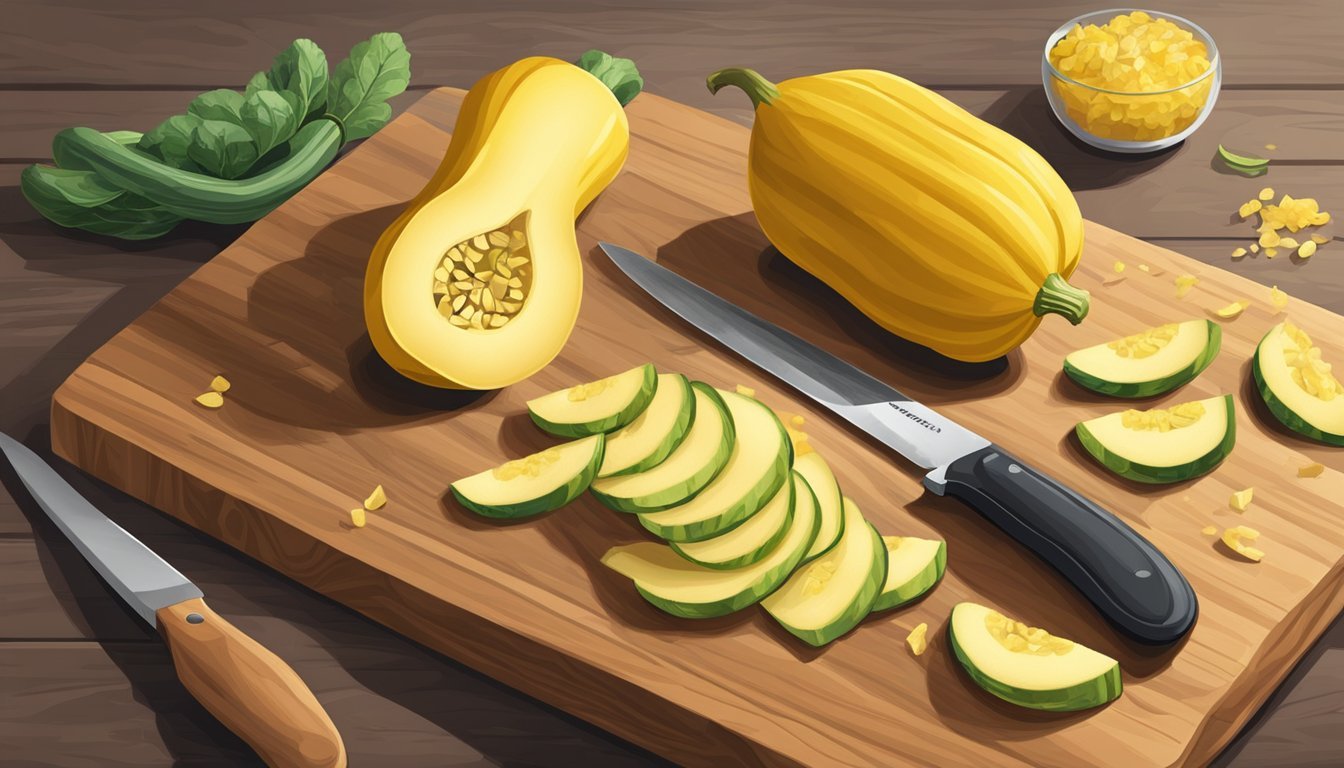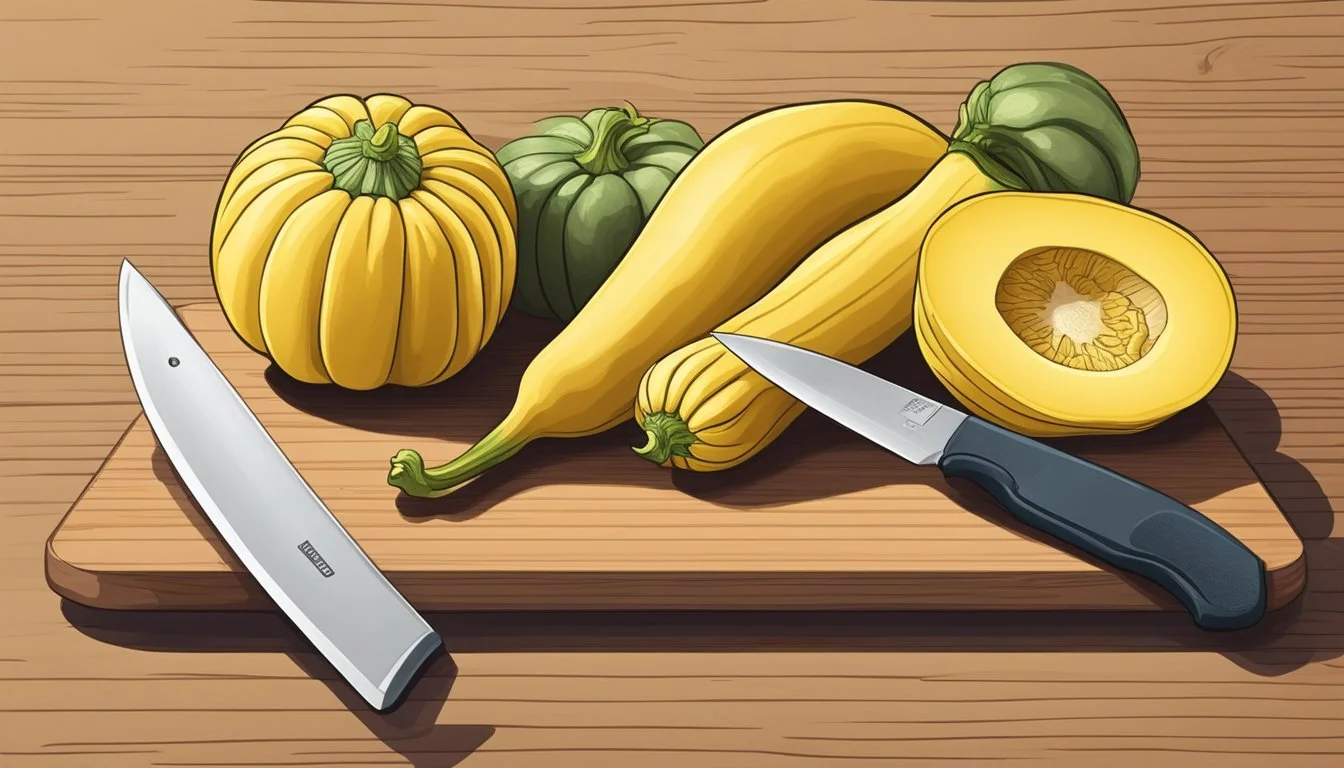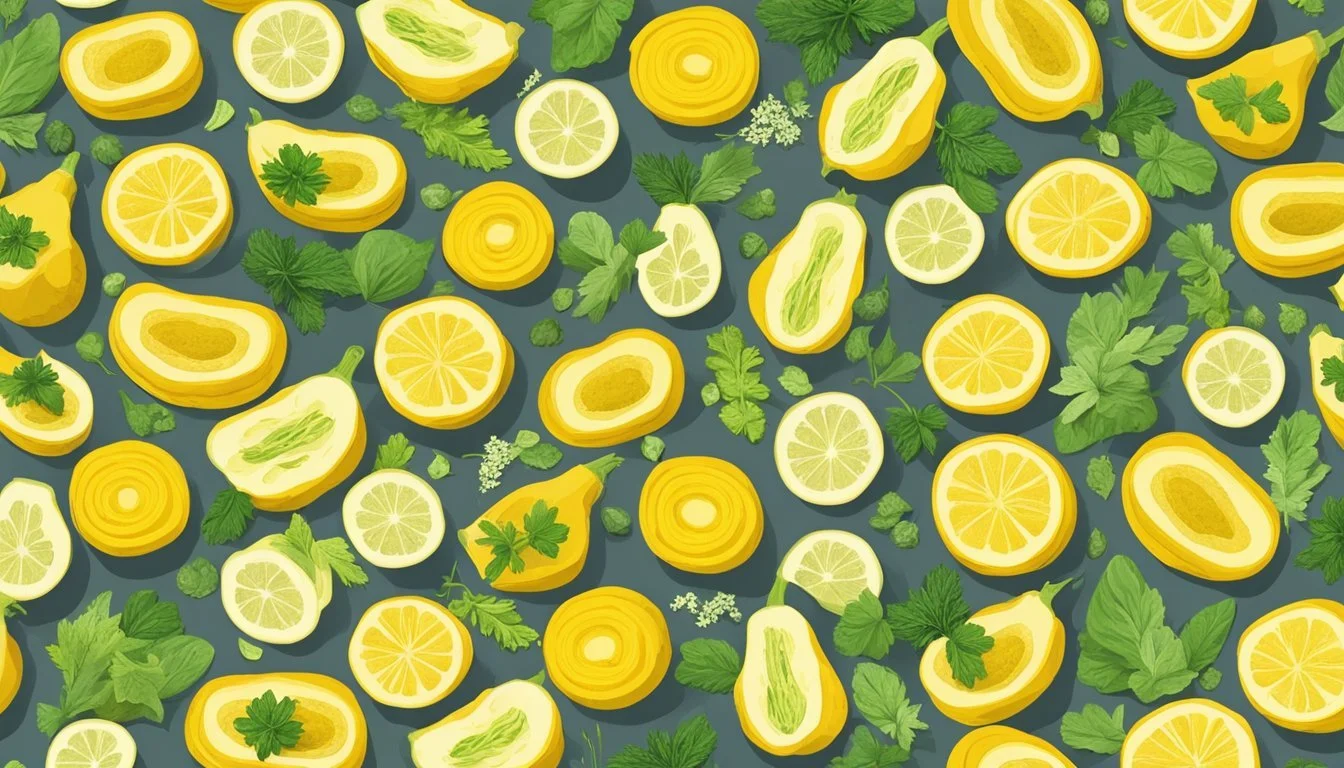How Do You Eat Yellow Squash?
Simple Preparation Tips and Recipes
Yellow squash, a versatile and nutritious vegetable, is enjoyed in various cuisines around the world for its delicate flavor and health benefits. Known for its vibrant yellow color, this summer squash variety is low in calories and provides a good source of vitamins A and C, fiber, and potassium. Whether one is looking to include more vegetables in their diet or simply enjoys the taste of yellow squash, there are numerous ways to prepare and eat it.
From being roasted in the oven to grilling on a barbecue, yellow squash can adapt to a wide array of cooking methods. Its subtly sweet flavor complements a variety of seasonings and other ingredients, making it a favorable addition to many dishes. It can be eaten raw, steamed, sautéed, or baked, and it is commonly sliced into rounds or strips depending on the recipe.
One enjoys yellow squash not only for its taste but also for its ease of preparation. It requires minimal seasoning, often just a sprinkle of salt and pepper, to enhance its natural flavor. Additionally, its soft texture after cooking makes it an excellent choice for a quick side dish or a main course when paired with proteins and grains. With its numerous preparation options and health benefits, yellow squash stands out as an accessible choice for anyone looking to diversify their vegetable intake.
Nutritional Profile of Yellow Squash
Yellow squash is a nutrient-dense food offering a host of vitamins, minerals, and dietary fiber while being low in calories and fat. This vegetable can be a valuable part of a balanced diet providing essential nutrients.
Vitamins and Minerals
Yellow squash is particularly rich in vitamins A and C, which are crucial for immune function, vision, and skin health. Additionally, it contains important minerals such as potassium and calcium. One cup of raw yellow squash typically contains the following:
Vitamin A: Essential for eye health and immunity.
Vitamin C: An antioxidant that supports the immune system and skin health.
Potassium: Helps control blood pressure and is essential for proper muscle and nerve function.
Calcium: Important for bone strength and cardiovascular function.
Iron: Vital for blood production and oxygen transport.
The antioxidants present, including carotenoids such as lutein and zeaxanthin, also contribute to reducing oxidative stress and supporting overall health.
Dietary Fiber and Macronutrients
While being low in carbohydrates and practically fat-free, yellow squash is a good source of dietary fiber. It adds bulk to the diet, which can aid in digestion and help maintain a healthy weight. Here's a breakdown:
Calories: Approximately 18 calories per cup, making it a low-calorie addition to meals.
Fat: Negligible amounts of fat, with only about 0.2 grams per cup.
Fiber: Good source of dietary fiber, important for digestive health.
Carbohydrates: Contains about 8 grams of carbs per medium squash, mainly consisting of fiber and sugar.
In summary, yellow squash is a versatile vegetable that provides essential nutrients without adding many calories or fat to the diet. It's a wholesome choice for those looking to increase their intake of vitamins and minerals while supporting overall health.
Preparation Basics
Proper preparation of yellow squash is essential for both safety and flavor. Starting with clean produce and employing the correct techniques for peeling and cutting can make a substantial difference in the culinary experience.
Washing and Peeling
Yellow squash should be thoroughly washed to remove any dirt or residues from its skin. Use cool running water and gently rub the skin with your hands or a vegetable brush. Peeling yellow squash is optional; their skin is typically tender and edible. However, if one prefers or if the skin seems tough, use a vegetable peeler to remove a thin layer of the skin.
Wash: Under cool running water
Peel: If desired, with a vegetable peeler
Cutting Techniques
Once the yellow squash is clean (and peeled if necessary), it's time to cut it. The squash can be sliced into rounds, normally recommended to be about 1/4 to 1/2 inch thick for even cooking. For dishes that require smaller pieces, one can cube the squash. To do so, first cut the squash into rounds, then stack a few rounds at a time and make a series of lengthwise and crosswise cuts.
Rounds: 1/4-1/2 inch thickness
Cubes: Cut rounds, then into quarters or smaller cubes as needed
Cooking Methods
Yellow squash is a versatile vegetable that can be prepared using various cooking techniques, each bringing out its texture and flavor in a unique way. The following methods highlight how to sauté, roast, grill, and bake this nutritious food.
Sautéing Yellow Squash
To sauté yellow squash, one should heat a sauté pan over medium-high heat with a combination of butter and olive oil. Once the butter melts, the squash can be added along with ingredients like garlic for extra flavor. Stirring occasionally, the squash should be cooked until tender, which typically takes about 8-10 minutes. Seasoning with kosher salt and a squeeze of lemon juice adds a fresh taste to the sautéed yellow squash.
Roasting Yellow Squash
Roasting in the oven requires preheating it to 425°F. After washing and slicing the yellow squash into 1/4-inch thick coins, they should be arranged in a single layer on a baking sheet. Drizzle with olive oil and sprinkle with kosher salt. Place in the oven to roast until they are tender and have a light golden color, which usually takes around 20-25 minutes. The high heat intensifies the squash's natural sweetness and results in a deliciously roasted texture.
Grilling Yellow Squash
Grilling yellow squash necessitates preheating the grill for at least 10 minutes. The squash should be cut into 1/2-inch thick slices, brushed with olive oil, and seasoned with salt and pepper. Placing the slices on the grill, one should cook them over medium-high heat, turning once, until they are marked by the grill and tender, which typically requires about 4-5 minutes on each side. The result is a smoky and grilled flavor.
Baking Yellow Squash
To bake yellow squash, one doesn't necessarily need to preheat their oven as with roasting. Yellow squash can be sliced and layered in a baking dish, seasoned with olive oil, garlic, salt, and other desired seasonings. It should be baked at a moderate temperature, around 350°F, until the squash is tender, about 30-40 minutes depending on the thickness. Baking is a gentle method that produces a soft and baked yellow squash.
Seasonings and Flavor Enhancers
When preparing yellow squash, the right seasonings and flavor enhancers can transform this versatile vegetable into a culinary delight. The addition of herbs, spices, citrus, cheese, and fats contributes layers of flavor, creating a balance between richness and zest.
Herbs and Spices
Garlic Powder: A sprinkle enhances the natural sweetness of squash with its distinct garlicky flavor.
Onion Powder: This adds a slightly sweet taste that marries well with the squash's profile.
Thyme: Fresh thyme leaves bring a subtle, earthy tone to the dish.
Black Pepper: A pinch of freshly ground black pepper adds a mild heat and pungency.
Red Pepper Flakes: For those who enjoy a spicy kick, a light scattering of red pepper flakes can be added.
Citrus and Acidity
Lemon Juice: A squeeze of lemon juice can be used to brighten the squash's flavors, adding a refreshing tanginess.
Vinegar: A small dash of vinegar may also serve as an acid component, elevating the taste further.
Cheeses and Fats
Parmesan Cheese: Topping roasted or sautéed squash with grated Parmesan cheese creates a crisp, golden crust and adds a salty, umami flavor.
Olive Oil: Drizzled and tossed with squash before roasting, it aids in cooking and introduces a subtle fruitiness.
Yellow Squash Dishes
Yellow squash is a versatile vegetable that can be incorporated into a variety of dishes. From simple sides to main courses and healthy salads or soups, its subtle flavor and vibrant color enhance any meal.
Simple Side Dishes
To prepare a quick and effortless side dish, one might slice yellow squash and toss it with olive oil, garlic, and parmesan, then roast in the oven until tender. For a steamed version, just a bit of water in a microwavable bowl with the squash slices covered for 3-5 minutes will suffice. Season with salt, pepper, and herbs to taste.
Roasted Yellow Squash
Ingredients: Yellow squash, olive oil, garlic, parmesan
Instructions: Slice squash, toss with oil and spices, bake at 400°F for 12-14 minutes.
Main Courses
Yellow squash plays well as a star in a variety of main course dishes. Incorporating it into pasta dishes or rice enhances the meal with a nutritional boost and a pop of color. Squash casserole is a hearty option, where squash is layered with cheese and baked until bubbly. Vegetarians might opt for yellow squash lasagna, replacing pasta layers with squash slices.
Yellow Squash Pasta
Ingredients: Yellow squash, pasta, garlic, olive oil, simple ingredients
Recipe Variations: Add protein such as chicken or tofu to elevate the dish.
Salads and Soups
A fresh yellow squash salad is perfect for fall, simply tossed with olive oil, lemon, and herbs. For cooler days, squash can be transformed into a comforting soup, pureed with ingredients like butternut squash for a creamy texture. Recipe variations might include vegetarian and vegan options, omitting animal-derived components.
Creamy Yellow Squash Soup
Ingredients: Yellow squash, butternut squash, vegetable stock, garlic, olive oil
Hints: Use a blender to achieve a smooth, creamy consistency without the need for cream.
Serving and Presentation
Yellow squash, with its mellow flavor and tender texture, provides ample opportunity for creative serving and presentation. It can be transformed into both a visually appealing and delicious component on any plate.
Pairings and Accompaniments
Yellow squash pairs excellently with a variety of flavors and components. A list of suitable pairings include:
Proteins: Grilled or roasted meats, such as chicken or pork, benefit from the lightness of squash as a side dish.
Herbs and Spices: Fresh thyme or basil complement the squash's subtle taste.
Cheeses: A sprinkle of feta or Parmesan cheese can add a salty, tangy contrast to the sweetness of the squash.
Other Vegetables: Mixed vegetable medleys often include yellow squash alongside bell peppers, onions, and tomatoes.
Lemon: A squeeze of lemon juice enhances the squash's flavor, refreshing the palate.
When considering accompaniments, one should not overlook the rich addition that bacon can offer, especially when the squash is roasted or sautéed.
Plating and Garnishes
The visual presentation of yellow squash can elevate any dish. Here are some tips for effective plating and garnish:
Consistency in Cuts: Uniformly sliced squash, whether in rounds or cubes, ensures balanced cooking and an attractive arrangement.
Garnishes: A sprig of fresh thyme or a lemon wedge can add color and invite the senses to the flavors that await.
Layering: Placing the squash under or around a main protein can enhance the aesthetic of the plate, highlighting the squash as a thoughtful side.
One should present yellow squash in a manner that underscores its versatility and complements the main dish without overpowering it.
Storage and Reheating Instructions
Proper storage maximizes the shelf life of yellow squash, while correct reheating methods ensure that its texture and flavor are preserved. This section will detail how to store fresh yellow squash to maintain its freshness and how to reheat leftovers to enjoy them at their best.
Preserving Freshness
Upon acquiring fresh yellow squash, one should first wash it, then trim the ends, and pat it dry to remove excess moisture. To prolong its freshness, storage in a refrigerator is recommended. A plastic bag with a few punctured holes provides ventilation and reduces moisture accumulation. It's crucial for the bag to be sealed but not entirely airtight, allowing for some air circulation. The crisper drawer is an ideal spot due to its consistent temperature and humidity levels. This method can keep yellow squash fresh for up to two weeks.
Revitalizing Leftovers
When it comes to reheating leftover yellow squash, the key is to restore warmth without compromising its texture. One should preheat the oven to 350°F for even heating. Leftover squash should be cut into uniform pieces for consistent cooking. Using a lined baking sheet simplifies cleanup and prevents sticking. The squash pieces should be spread in a single layer on the sheet. Reheat the squash until it’s warmed through; this usually takes about 10-15 minutes, depending on the size of the pieces. If one desires to crisp up the skin, they can broil the squash on high for 2-3 minutes. For a quick reheat, the microwave can also be used by covering the squash and microwaving it for a few minutes. However, this method may not preserve the texture as effectively as oven reheating.
Selecting and Storing Yellow Squash
When choosing yellow squash, one should look for firmness and vibrant color. Proper storage can substantially extend its freshness, making it a versatile ingredient for summer dishes.
Buying Guide
Farmers Market vs. Grocery Store: Yellow squash from a farmers market is often fresher than grocery store offerings, but look for the same qualities in both places.
Appearance:
Color: A bright, golden hue indicates ripeness.
Texture: The skin should be smooth and free of blemishes or soft spots.
Stem: A moist stem end suggests recent harvest.
Varieties: While there are many types of summer squash, 'zephyr' is a popular variety known for its distinctive two-tone color and sweet, nutty flavor.
Storage Tips
Refrigeration: Store yellow squash in the crisper drawer of your refrigerator, ideally in a plastic bag with some air holes for circulation.
Preparation for Freezing:
Slice or chop the squash into desired sizes.
Blanch in boiling water mixed with 1 tsp of citric acid per gallon for three minutes then immediately dunk in ice water to halt cooking. Drain well.
Freezing: After blanching, dry pieces thoroughly and place them in a single layer on a baking sheet to freeze. Once frozen, transfer to airtight containers or freezer bags to store.
Dehydrating:
For a longer shelf life, dehydrated yellow squash is an option. After being sliced and blanched, pieces can be dehydrated until brittle and then stored in airtight containers.
Health Considerations and Dietary Adaptations
When incorporating yellow squash into a diet, it's essential to consider its nutritional profile and how it aligns with various dietary needs and restrictions. The low calorie and fat content of yellow squash make it a versatile vegetable for many, including those on vegetarian or vegan diets.
Caloric and Fat Content
Yellow squash is a low-calorie food, providing a minimal impact on daily caloric intake. It is also low in fat, making it suitable for low-fat diet plans. A typical serving size of yellow squash (about 1 cup of sliced squash) contains:
Calories: Approximately 20
Fat: Less than 0.2 grams
Allergies and Intolerances
Although uncommon, some individuals may experience allergies or intolerances to squash. Signs of a food allergy can include hives, itching, or gastrointestinal distress after consumption. Individuals with known allergies or food sensitivities should consult with a healthcare provider before adding yellow squash to their diets.
Vegetarian and Vegan Variations
Yellow squash is inherently suitable for both vegetarian and vegan diets, contributing essential nutrients without compromising dietary restrictions. Here's how yellow squash benefits these diets:
Vegetarian Diet: Provides important nutrients such as vitamin C, magnesium, and folate.
Vegan Diet: An excellent vegetable to ensure adequate intake of fiber and beta-carotene, while also being a whole food that complements plant-based protein sources.





